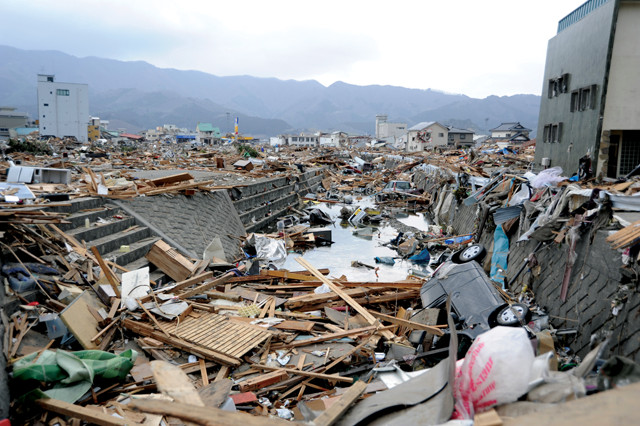
by Mary Caperton Morton Thursday, February 16, 2017

Debris lines a canal in the coastal Japanese town of Ofunato following the March 2011 Tohoku earthquake. Credit: U.S. Navy photo by Mass Communication Specialist 1st Class Matthew M. Bradley.
Large earthquakes alter the planet’s gravitational field by displacing big portions of the crust. In a new study looking at earthquake-induced gravity signals produced by Japan’s magnitude-9 Tohoku quake in 2011, researchers conclude that such signals may prove useful in earthquake early warning systems.
“During an earthquake, you have an instantaneous mass redistribution, and when you move mass, you change the way that gravity pulls on that mass,” says Jean-Paul Montagner, a geophysicist at the Paris Institute of Earth Physics in France and lead author of the new study, published in Nature Communications. That change creates a transient “gravity signal,” which becomes detectable within seconds to minutes after a rupture.
The Tohoku quake provided an ideal opportunity to study the effects of the quake on Earth’s gravity, Montagner says. The event struck just 500 kilometers from a specialized superconducting gravimeter housed at the Kamioka Observatory in Gifu Prefecture, Japan. “This instrument was in a good configuration to pick up the [gravity] signal, not too close or too far from the earthquake,” he says.
When Montagner and colleagues went back through the data collected by the gravimeter during the Tohoku event, they found a detectable gravitational shift approximately 65 seconds after the initial rupture, and about nine seconds before the first P-waves arrived in the area of the gravimeter. Gravity signals travel very near the speed of light, so the signals can be detected before seismic waves, which travel at closer to the speed of sound at Earth’s surface. Such earthquake-induced gravity signals have never been detected before, in part because they are so small that they are usually drowned out amid the seismic noise produced by large earthquakes.
Detecting such signals also runs scientists into a famous conundrum in physics: Distinguishing rapid gravitational changes from subsequent inertial accelerations of the planet is often impossible. When gravity changes suddenly, the resulting unbalanced forces on Earth are countered by accelerations in Earth’s mass that are equal and opposite to the gravity changes, so the two forces effectively cancel each other out. And because the changes happen almost instantaneously and nearly simultaneously, telling them apart in gravimetry data is challenging.
“This problem is part of what led Einstein to develop his theory of general relativity,” says Thomas Heaton, a geophysicist at Caltech who was not involved with the study. “As long as the gravimeter is on the surface of the Earth, it will be very difficult, if not impossible, to pick out gravitational changes from the motions of the Earth itself.”
Montagner says the Tohoku event provided the perfect scenario — a very large earthquake occurring near a gravimeter — to pick out gravity signals, and improvements in instrumentation, especially gravity gradiometers, could improve detection capabilities. Gravity signals start off small and then grow, so a more sensitive instrument may have been able to detect the signal even sooner, he says. “We are at the limit of sensitivity for these [current] instruments,” he says. “That’s how science often works: We work at the limits of our knowledge and capabilities. Perhaps in the future, we will find a better way of detecting these signals.”
If researchers can reproduce the findings of this study for another large earthquake, such as the magnitude-8.2 quake that struck Iquique, Chile, in 2014, it would support the notion that gravity shifts from large quakes could be useful in earthquake early warning systems in the future, Montagner says. Currently, most earthquake early warning systems, like ShakeAlert, used on the U.S. West Coast, rely on the detection of P-waves, which travel faster and arrive seconds before the more destructive S-waves.
The idea of using gravity signals for earthquake early warning systems faces skepticism, however. “When it comes to early warning systems, there are more promising ways to improve our system than looking for gravity changes,” Heaton says, such as improving P-wave detection algorithms and the logistics of early warning system networks.
But if gravity waves could potentially provide even a few more seconds of notice ahead of damaging shaking, it could make a big difference, Montagner says. “If we can save just two or three seconds, it might be enough time to stop trains, nuclear plants, elevators and cars,” which could mitigate damage and casualties.
© 2008-2021. All rights reserved. Any copying, redistribution or retransmission of any of the contents of this service without the expressed written permission of the American Geosciences Institute is expressly prohibited. Click here for all copyright requests.